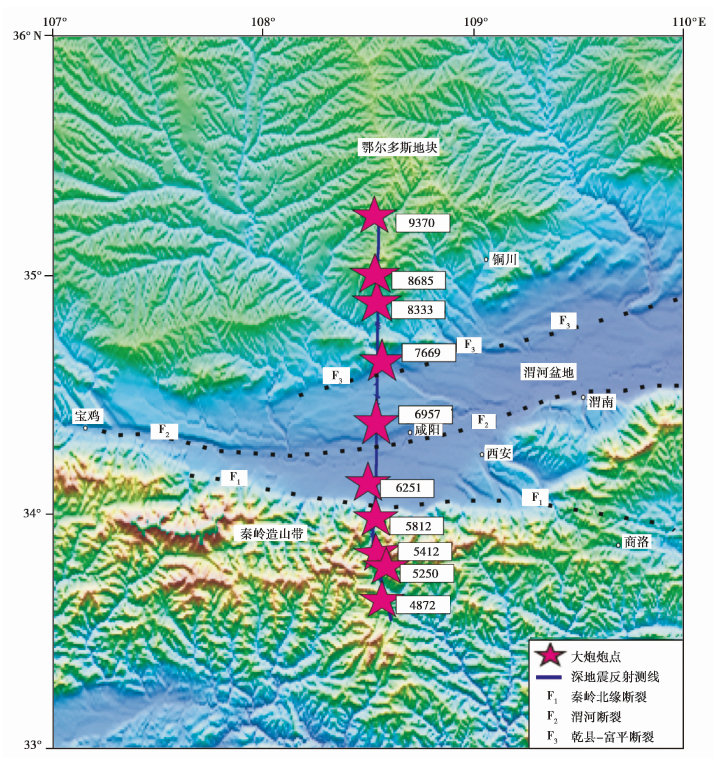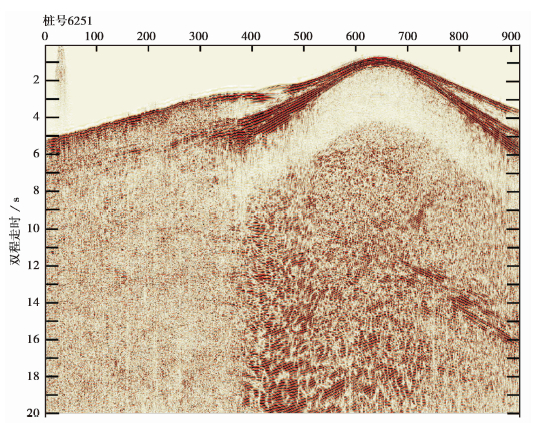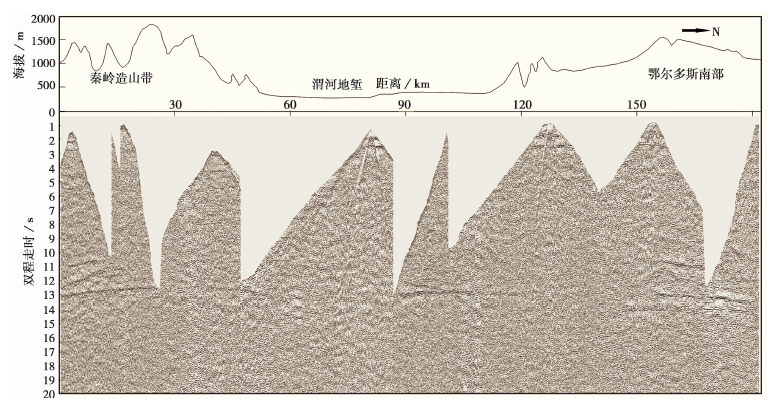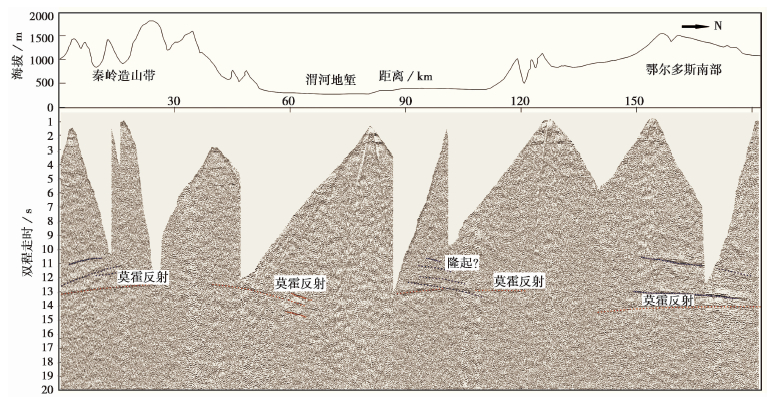作为构建岩石圈与地壳结构的一个重要端元,莫霍面并非是简单的地震界面,而是地下岩浆作用、构造作用及深成作用等多种地质作用的产物(Carbonell et al.,2013;Mjelde et al.,2013)。莫霍面是地壳和地幔的一个边界层与重力补偿面,是壳幔物质与能量交换的重要边界,它记录了地壳的演化历史,也是地壳生长和增生的关键部位。因而,莫霍面研究对地壳、地幔的形成、演化及深层动力学过程均有重要作用(滕吉文等,2006;Cook et al.,2010;Thybo et al.,2013)。下地壳及莫霍面的深度、几何形态、内部结构及成分等信息可以为壳幔相互作用提供约束,是构建地球动力学模型的关键,利用高精度的深地震反射方法对下地壳及莫霍面结构进行探测,对研究地壳生长、增生、底侵、拆沉等作用具有重要意义(Chen et al.,2013;Rabbel et al.,2013)。
研究区位于青藏高原东面,包括秦岭造山带北缘、渭河地堑、鄂尔多斯地块南缘,是华北克拉通和扬子板块之间的重要构造单元。秦岭造山带的形成演化记录了华北克拉通与华南陆块长期多阶段拼合过程,晚元古代—中三叠世华北、秦岭、扬子3板块依次沿商丹和勉略两条缝合带由南向北俯冲碰撞造山,伴随着逆掩推覆和强烈隆升以及后期的走滑作用,该区发生了大规模的酸性岩浆活动(张成立等,2008),奠定了基本构造格局,由于后期强烈的陆内造山作用的叠加、改造,最终形成了复合型造山带(Meng and Zhang,1999;张国伟等,2001,2003)。渭河盆地的形成始于始新世,到上新世时渭河断陷带已形成,由于受到秦岭造山带、北山山前断裂带等相邻正断层倾滑运动的控制,断陷带主要表现为大幅度沉陷、扩张并接受了较厚的沉积,其内部产生了一系列向南倾斜的断层差异运动,且在新近时期垂直差异运动十分强烈(冯希杰等,2008)。鄂尔多斯地块是华北地块西部的一部分,其浅部为叠加在华北克拉通基底上的中生带陆内沉积盆地(张岳桥等,2003),对该区莫霍面结构的研究和探索有助于研究华北克拉通与扬子克拉通两大块体的相向运动轨迹、碰撞作用过程及界带的构造变形(袁学诚等,1994;Dong et a1.,2014)。
当前研究区的地球物理探测主要有大地电磁(程顺有等,2003;胡国泽等,2014)、重力(王谦身等,2015)、地震测深(滕吉文等,2014a,2014b)和宽频带研究(徐树斌等,2013;Wang et al., 2014a,2014b)等,尽管秦岭地区曾做过深地震反射研究,但由于数据和方法的局限性,仅限于分辨率较低的大尺度研究,对于莫霍面结构,只能得到整体构造格架,不能分辨下地壳—莫霍面内部的精细结构、细小层位及变化。为了获得秦岭造山带的深部精细构造影像和特征,中国地质科学院地质研究所在2013年4月~9月开展了跨越秦岭的深地震反射数据采集工作。本文选用北线的大炮数据,根据近垂直反射原理对大炮资料进行针对性的精细数据处理,获得了莫霍面的形态结构和变化特征。
1 数据采集深地震反射测线的北线自南向北依次穿过北秦岭、渭河地堑和鄂尔多斯地块南部,主要跨越秦岭北缘断裂、渭河断裂、乾县—富平断裂(图 1)。为了获得全地壳的成像结构,根据“浅深兼顾、大中小炮结合”的原则,针对不同的目的层设计了大、中、小3种激发药量的震源:小炮在浅层成像中起主要作用;中炮主要用于对中、深层成像;大炮主要用于约束深部构造形态,为资料的后续处理、解释提供质控与指导。

|
图 1 深地震反射测线位置图 Fig.1 The survey line of deep seismic reflection |
小炮激发药量为24~48 kg,间距为200 m;中炮激发药量为48~96 kg,间距为1 km;大炮激发药量为500~2 000 kg,间距为50 km。中、小炮排列激发,600道接收,采样率为2 ms,记录长度为30 s;大炮采用单边放炮,1 000道接收,采样率为4 ms,记录长度为60 s;检波点距为40 m。因大炮激发药量较大,对激发点要求苛刻,导致个别大炮的激发位置有所偏离了测线,如图 1中桩号为5250、6251和7669的炮点。但炮点位置的偏移对浅层的成像影响较大,对深部成像影响较小。
2 数据处理数据处理的目的是消除或减小观测方式、地表、人类活动等不可控因素对地震波走时、振幅、频率的影响,还原地下真实的构造形态及波阻特征。浅层由于受物性影响,即使是大炮,也很难形成信噪比较高的单次连续剖面,因此解决好大炮的静校正和噪声衰减是单次剖面的关键。
考虑到大炮数量较少,大、中、小炮都是同测线的,故拾取中、小炮初至进行层析静校正计算,最终选取基准面为2 000 m,替换速度为4 000 m/s。
原始大炮的干扰波主要是异常振幅、面波、线性干扰、低频干扰(1~2 Hz)、50 Hz工业干扰、雷击现象引起的电磁感应噪声等。大炮的深层有效反射波主频为6~20 Hz,和面波主频有重叠,因此首先对单炮数据进行异常振幅分频压制法去除异常振幅,用自适应面波衰减法来压制面波;对于线性干扰,则根据干扰波和有效波在视速度、位置和能量上的差异,在T-X域采用倾斜叠加的方法向前、向后线性叠加以确定线性干扰的视速度范围,从而将识别出的线性干扰从原始数据中减去;对低频干扰和50 Hz工业干扰,则通过低截频和高截频滤波消除;电磁感应噪声的特点是宽频带、强振幅、尖脉冲、水平分布,很难通过频率等其它域去噪方法压制,故通过手工方式剔除。
图 2和图 3是去噪后的深地震反射大炮剖面,可见大炮深部莫霍反射信噪比较高,随后对处理后的单炮进行集合扩散补偿和地表一致性处理,最后按共反射点进行展布,图 4是处理后获得的单次覆盖剖面。

|
图 2 桩号为6251的大炮地震记录剖面 炮点位于渭河地堑,检波点排列于北秦岭和渭河地堑(自动增益时窗长为5 s,滤波参数为2-4-18-25 Hz) Fig.2 The record of large charge shot station No.6251 |

|
图 3 桩号为9370的大炮地震记录剖面 炮点位于测线最北端的鄂尔多斯南段,检波点排列于鄂尔多斯南部(自动增益时窗长为5 s,滤波参数2-4-18-25 Hz) Fig.3 The record of large charge shot station No. 9370 |

|
图 4 秦岭深地震反射北线单次覆盖剖面图 Fig.4 The single fold section of deep seismic reflection in the north of Qinling orogen |
在秦岭造山带,莫霍面反射的双程走时约为13 s,自南向北缓慢抬升变浅,30 km处达到最浅点12.5 s。进入渭河地堑,莫霍面反射逐步加深到15 s左右,继续向北不能追踪,在90 km左右处出现较强的莫霍面反射震相,双程走时为13.2 s左右,自此向北震相先逐步抬升但变化梯度较小,继续向北追踪,莫霍面震相模糊难以追踪。在140 km左右出现莫霍面反射震相,向北可连续追踪,并有逐渐抬升的趋势,但变化平缓,在测线最北端,莫霍面反射的双程走时为14 s左右。
4 认识与结论本文通过秦岭深地震反射的10个大炮对该区莫霍面进行成像研究,充分利用深地震反射大炮能量强、信噪比高、深部反射可连续的特点,制定了针对性的大炮数据处理流程,选取的合适的处理参数,获得了较高信噪比的单次覆盖剖面。初步解释结果如下:
北秦岭:在北秦岭,莫霍面反射的双程走时约为13 s,自南向北缓慢抬升变浅至12.5s,显示北秦岭不存在山根,可能表示秦岭正在经历造山后的均衡演化过程:造山带挤压导致地壳增厚(高山等,1999;冯涛等,2000),引起北秦岭岩石圈地幔拆沉,幔源物质和热流体上涌,发生强烈的壳幔物质交换,中、下地壳加热、部分熔融并强烈伸展流变,形成近水平的莫霍面(Meng and Zhang,1999;张国伟等,2001,2003;朱赖民等,2008),该莫霍面可能代表新生代形成的莫霍面。在北秦岭与渭河地堑交界处(60 km处)有3组较强的北倾震相(图 5),与深地震反射(任隽等,2013)、深地震测深(Shi et al.,2008;任枭等,2012;滕吉文等,2014a)、宽频带的观测结果一致(Wang et al.,2014a,Wang et al.,2014a)。这些倾斜震相可能表明新生代形成后的莫霍面受到了强烈的挤压作用。

|
图 5 秦岭深地震反射北线单次覆盖剖面解释图 红色虚线表示Moho反射震相,蓝色虚线表示下地壳反射震相 Fig.5 The interpreted single fold section of deep seismic reflection in the north of Qinling orogen |
渭河地堑:进入渭河地堑,莫霍面加深至15 s左右,地堑两侧的莫霍界面呈不对称上隆。单次剖面60~90 km处莫霍反射不能连续追踪,徐树斌等(2013)利用S波反演得到的该区的地壳与地幔速度界面特征也不明显,并认为这些与渭河地堑的松散沉积层有关,但并不说明渭河地堑下方不存在莫霍面。我们推测这是由新生代中期的伸展作用引起地幔物质上涌,导致中、下地壳物质成分相对均一,上、下介质阻抗差小,因此不能成像。剖面90~120 km处莫霍面整体抬升变浅,中、下地壳有4个反射层位,也呈现不对称的隆起。
鄂尔多斯南缘:单次剖面120~150 km处地壳厚度大,结构相对简单,莫霍面从测线最北端向南逐渐加深,但变化平缓,反射为14 s左右。在130~140 km左右处莫霍面不能连续追踪,但两侧莫霍面皆具有显著的反射特征差异,可能代表渭河地堑和鄂尔多斯地块南部的深部界限。
| [1] | 程顺有,张国伟,李立. 2003. 秦岭造山带岩石圈电性结构及其地球动力学意义.地球物理学报, 46(3):390-397. |
| [2] | Cheng Shunyou, Zhang Guowei and Li Li. 2003. Lithospheric electrical structure of the Qinling orogen and its geodynamic implication. Chinese Journal of Geophysics, 46(3):390-397. |
| [3] | 冯希杰,李晓妮,任隽等. 2008. 渭河断裂深、中、浅和近地表显示.地震地质, 30(1):264-272. |
| [4] | Feng Xijie, Li Xiaoni, Ren Jun et al. 2008. Manifestations of Weihe fault at deep, middle, shallow and near-surface depth. Seismology and Geology, 30(1):264-272. |
| [5] | 冯涛,谢静,陈亮等. 2000. 北秦岭造山带中的拆沉作用.西北地质科学, 21(2):15-19. |
| [6] | Feng Tao, Xie Jing, Chen Liang et al. 2000. Delamination of the northern Qinling orogenic belt. Northwest Geoscience, 21(2):15-19. |
| [7] | 高山,张本仁,金振民等. 1999. 秦岭-大别造山带下地壳拆沉作用.中国科学(D辑), 29(6):532-541. |
| [8] | Gao Shan, Zhang Benren, Jin Zhenmin et al. 1999. Lower crustal delamination in the Qinling-Dabie orogenic belt. Science in China(Series D), 42(4):423-433. |
| [9] | 胡国泽,滕吉文,阮小敏等. 2014. 秦岭造山带和邻域磁异常特征及结晶基底变异分析.地球物理学报, 57(2):556-571. |
| [10] | Hu Guoze, Teng Jiwen, Ruan Xiaomin et a1.2014. Magnetic anomaly characteristics and crystalline basement variation of the Qinling orogenic belt and its adjacent areas. Chinese Journal of Geophysics, 57(2):556-571. |
| [11] | 任隽,冯希杰,王夫运等. 2013. 深地震反射剖面揭示的渭河盆地西安坳陷的地壳精细结构.地球物理学报, 56(2):513-521. |
| [12] | Ren Juan, Feng Xijie, Wang Fuyun et al. 2013. Revealed the fine crust structures of Xi'an sag in Weihe Basin by deep seismic reflection profile. Chinese Journal of Geophysics, 56(2):513-521. |
| [13] | 任枭,徐志国,杨辉等. 2012. 鄂尔多斯地块东南缘地带Moho深度变化特征研究.地球物理学报, 55(12):4089-4096. |
| [14] | Ren Xiao, Xu Zhiguo, Yang Hui et a1.2012. Moho depth distribution character beneath the Ordos block's southeastern margin areas. Chinese Journal of Geophysics, 55(12):4089-4096. |
| [15] | 滕吉文. 2006. 地球深部壳-幔边界的层束精细结构与物理属性研究.吉林大学学报(地球科学版), 36(1):1-23. |
| [16] | Teng Jiwen. 2006. Research on layer-bundle fine structures and physical attributes of crust-mantle boundary in deep earth. Journal of Jilin University(Earth Science Edition), 36(1):1-23. |
| [17] | 滕吉文,李松岭,张永谦等. 2014a.秦岭造山带与邻域华北克拉通和扬子克拉通的壳、幔精细速度结构与深层过程.地球物理学报, 57(10):3154-3175. |
| [18] | Teng Jiwen, Li Songling, Zhang Yongqian et al. 2014a. Fine velocity structures and deep processes in crust and mantle of the Qinling orogenic belt and the adjacent North China Craton and Yangtze Craton. Chinese Journal of Geophysics, 57(10):3154-3175. |
| [19] | 滕吉文,李松岭,张永谦等. 2014b.秦岭造山带与沉积盆地和结晶基底地震波场及动力学响应.地球物理学报, 57(3):770-788. |
| [20] | Teng Jiwen, Li Songling, Zhang Yongqian. 2014b. Seismic wave fields and dynamical response for Qinling orogen and sedimentary basins and crystalline basement. Chinese Journal of Geophysics, 57(3):770-788. |
| [21] | 王谦身,滕吉文,张永谦等. 2015. 鄂尔多斯-中秦岭-四川东部的重力异常场与深部地壳结构.地球物理学报, 58(2):532-541. |
| [22] | Wang Qianshen, Teng Jiwen, Zhang Yongqian et al. 2015. Gravity anomalies and deep crustal structure of the Ordos Basin-Middle Qinling orogen-eastern Sichuan Basin. Chinese Journal of Geophysics, 58(2):532-541. |
| [23] | 徐树斌,米宁,徐鸣洁等. 2013. 利用接收函数研究渭河地堑及其周边地壳结构.中国科学:地球科学, 43(10):1651-1658. |
| [24] | Xu Shubin, Mi Ning, Xu Mingjie et al. 2013. Crustal structures of the Weihe graben and its surroundings from receiver functions. Science China Earth Sciences, 57(2):372-378. |
| [25] | 袁学诚,徐明才,唐文榜等. 1994. 东秦岭陆壳反射地震剖面.地球物理学报, 37(6):749-758. |
| [26] | Yuan Xuecheng, Xu Mingcai, Tang Wenbang et al. 1994. Eastern Qinling seismic reflection profiling. Chinese Journal of Geophysics, 37(6):749-758. |
| [27] | 张成立,王涛,王晓霞. 2008. 秦岭造山带早中生代花岗岩成因及其构造环境.高校地质学报, 14(3):304-316. |
| [28] | Zhang Chengli, Wang Tao and Wang Xiaoxia. 2008. Origin and tectonic setting of the Early Mesozoic granitoids in Qinling orogenic belt. Geological Journal of China Universities, 14(3):304-316. |
| [29] | 张国伟,张本仁,袁学诚等. 2001.秦岭造山带与大陆动力学.北京:科学出版社. 1-855. |
| [30] | Zhang Guowei, Zhang Benren, Yuan Xuecheng et al. 2001. Qinling Orogenic Belt and Continental Dynamics. Beijing:Science Press. 1-855. |
| [31] | 张国伟,董云鹏,赖绍聪等. 2003. 秦岭-大别造山带南缘勉略构造带与勉略缝合带.中国科学(D辑), 33(12):1174-1183. |
| [32] | Zhang Guowei, Dong Yunpeng, Lai Shaocong et al. 2004. Mianlue tectonic zone and Mianlue suture zone on southern margin of Qinling-Dabie orogenic belt. Science in China(Series D), 47(4):300-316. |
| [33] | 张岳桥,杨农,陈文等. 2003. 中国东西部地貌边界带晚新生代构造变形历史与青藏高原东缘隆升过程初步研究.地学前缘, 10(4):599-612. |
| [34] | Zhang Yueqiao, Yang Nong, Chen Wen et al. 2003. Late Cenozoic tectonic deformation history of the east-west geomorphological boundary zone of China and uplift process of the eastern margin of the Tibetan. Earth Science Frontiers, 10(4):599-612. |
| [35] | 朱赖民,张国伟,李犇等. 2008. 秦岭造山带重大地质事件、矿床类型和成矿大陆动力学背景.矿物岩石地球化学通报, 27(4):384-390. |
| [36] | Zhu Laimin, Zhang Guowei, Li Ben et al. 2008. Main geological events, genetic types of metallic deposits and their geodynamical setting in the Qinling orogenic belt. Bullet in of Mineralogy, Petrology and Geochemistry, 27(4):384-390. |
| [37] | Carbonell R, Levander A and Kind R. 2013. The Mohorovičić discontinuity beneath the continental crust:An overview of seismic constraints. Tectonophysics, 609:353-376. |
| [38] | Chen W P, Yu C Q and Tseng T L. 2013. Moho, seismogenesis, and rheology of the lithosphere. Tectonophysics, 609:491-503. |
| [39] | Cook F A, White D J, Jones A G et al. 2010. How the crust meets the mantle:Lithoprobe perspectives on the Mohorovičić discontinuity and crust-mantle transition. Canadian Journal of Earth Sciences, 47(4):315-351. |
| [40] | Dong Y P, Zhang X N, Liu X M et al. 2014. Propagation tectonics and multiple accretionary processes of the Qinling orogen. Journal of Asian Earth Science, 104:84-98. |
| [41] | Meng Q R and Zhang G W. 1999. Timing of collision of the North and South China blocks:Controversy and reconciliation. Geology, 27(2):123-126. |
| [42] | Mjelde R, Goncharov A and Müller R D. 2013. The Moho:Boundary above upper mantle peridotites or lower crustal eclogites?A global review and new interpretations for passive margins. Tectonophysics, 609:636-650. |
| [43] | Rabbel W, Kaban M and Tesauro M. 2013. Contrasts of seismic velocity, density and strength across the Moho. Tectonophysics, 609:437-455. |
| [44] | Shi Y Q, Feng X J, Dai W Q et al. 2008. Distribution and structural characteristics of the Xi'an section of the Weihe fault. Acta Seismologica Sinica, 21(6):636-651. |
| [45] | Thybo H and Artemieva I M. 2013. Moho and magmatic underplating in continental lithosphere. Tectonophysics, 609:605-619. |
| [46] | Wang P, Huang Z C, Mi N et al. 2014a. Crustal structure beneath the Weihe Graben in central China:Evidence for the tectonic regime transformation in the Cenozoic. Journal of Asian Earth Sciences, 81:105-114. |
| [47] | Wang C Y, Sandvol E, Zhu L et al. 2014b. Lateral variation of crustal structure in the Ordos block and surrounding regions, North China, and its tectonic implications. Earth and Planetary Science Letters, 387:198-211. |
 2016, Vol. 51
2016, Vol. 51


